Paid Work
OUTCOMES
Access to meaningful, rewarding and safe employment is available to all.
INTRODUCTION
Income from paid work is a primary determinant of living standards for the great majority of New Zealanders. Approximately two-thirds of total household income is derived directly from labour market income and the figure is substantially greater for most households. Income saved during working life contributes to the standard of living of many retired people.
Paid work is also an important way for people to participate in society, attain social status and enjoy a sense of social connectedness. Those who experience unemployment, particularly long-term or recurrent unemployment, can become isolated from society and their community and often lose self-confidence42. Substantial evidence from New Zealand and overseas suggests that unemployment is associated with poorer mental and physical health43. It is important, too, that people have access to jobs that match their training, skills and experience and fit with their career aspirations.
Several inter-related factors affect the number and types of jobs in the economy at any one time. These include the demand for and supply of skills, and the processes that match demand with supply. Economic conditions here and internationally influence the demand for goods and services, investment decisions, and actions by Government. These in turn affect skill demand. People's and businesses' training and education decisions, migration flows and individuals' decisions on how much time to allocate to paid work all influence skill supply. In making decisions regarding paid work, individuals take into account factors such as likely wages, childcare responsibilities and costs, and other activities such as voluntary work and leisure pursuits.
These important interactions highlight the links between the indicators in this domain and those in others, particularly the Knowledge and Skills and Economic Standard of Living indicators.
The first two indicators chosen for this chapter - the unemployment rate and the employment rate - together provide a picture of trends in the labour market. The unemployment rate measures those who are out of work, actively seeking a job and available to take up work. The employment rate measures the percentage of people in employment and is influenced by trends in labour force participation as well as in unemployment.
There are many ways of measuring unemployment. The indicator selected here is the one that most closely accords with the OECD standardised measure. It is, however, a comparatively narrow definition. A broader measure, known as the "jobless" rate, includes people who are unemployed but do not meet the stricter unemployment rate definition because they are either not available for work immediately or were not actively seeking employment at the time of the survey. The jobless rate is typically 50-70 per cent higher than the official unemployment rate.
Both indicators focus on the quantity of employment and unemployment and the way these are spread across different groups in the community. Ideally these measures would be supplemented by measures of the quality of paid work - how "good" the available jobs are, including how satisfied people are with their employment situation. Unfortunately no robust data currently exists in these areas. The third indicator provides a measure of one aspect of job quality - the rate of workplace injury claims. Safety at work is a vital contributor to well-being.
KEY POINTS
- Unemployment increased sharply between 1987 and 1991. It fell between 1992 and 1996, rose slightly in 1997-98, and has been falling over the past three years. This rate is still above the rate of four per cent that existed in the mid-1980s.
- The employment rate shows that currently almost 72 per cent of those aged 15-64 are in paid work. This is substantially higher than the 65 per cent employed in 1992, and almost the same as the 72 per cent figure of 1986. The women's employment rate is substantially below that of men, although this gap has been narrowing over the last few decades as more women participate in the paid labour force.
- The rate of workplace injury claims was 143 accident claims per 1,000 full-time equivalent employees in the 2000/2001 year. Men are more than twice as likely as women to have workplace accidents, a fact associated with the types of industries and occupations in which men predominate.
SUMMARY
Both employment indicators show a generally improving trend over recent years, but the situation has not yet returned to 1986 levels. Compared with other OECD countries, New Zealand's unemployment rate is now average. Unemployment continues to be unevenly distributed across different groups in the community. In particular, although Māori and Pacific peoples' unemployment rates have fallen since 1992, both rates remain considerably higher than the European unemployment rate. Within groups, the prevalence of unemployment is also unequally shared. While a large number of people are unemployed at some point in their lives, the experience of unemployment is concentrated in a relatively small proportion of the community who are unemployed for long periods of time or experience repeated spells of unemployment. Long-term and repeated unemployment has the most serious social and economic consequences and is associated with low economic standards of living and potentially negative impacts on children. It can also lead to a depreciation in skills, alienation from the labour market and a decline in self-confidence and self-esteem.
Regional differences in employment outcomes, while narrower than a decade ago, continue to be significant. Moreover, the data on broad regional classifications reported here hides the much greater variations in employment and unemployment rates that exist at community level.
Work-related accident data shows some industries, such as forestry, construction and manufacturing have particularly high accident rates. There were 49 fatal accident claims in 2000/2001 - more than half in the forestry, fishing, agriculture, construction and transport industries.
Unemployment
DEFINITION
The number of people, aged 15 and over, who are not employed and are actively seeking and available for paid work, expressed as a percentage of the total labour force. (The labour force is defined as those aged 15 and over who are employed, plus those who meet the definition of unemployed.)
RELEVANCE
A key indicator of labour market outcomes and lack of access to employment. The unemployment rate is an important reflection of overall economic conditions and of the ease with which people are able to move into employment.
CURRENT LEVEL AND TRENDS
In 2001, the unemployment rate averaged 5.3 percent of the labour force, or 102,500 people unemployed. The unemployment rate has steadily declined since 1998 and is considerably lower than the peak rate of 10.3 percent in 1991-92 (almost 170,000 people unemployed), but is higher than the rate of 4.0 percent in 1986 (64,000 people unemployed).
In 2001, 31 percent of the surveyed unemployed were unemployed for a continuous period of six months or more. This was higher than 22 percent in 1986 but significantly lower than the peak of 53 percent in 1992/93.
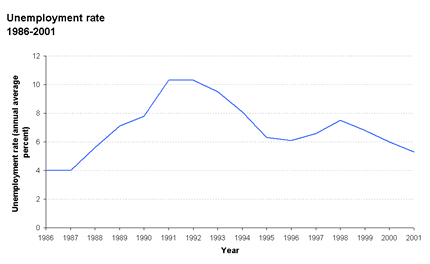
ETHNIC DIFFERENCES
Substantial differences in unemployment rates persist for different ethnic groups. Since 1986, Māori unemployment has risen from 10.7 percent to a peak of 25.4 percent in 1992 and declined to 12.3 percent in 2001. Between 1986 and 1991, the unemployment rate for Pacific peoples rose (from 6.5 percent to 28 percent), the highest rate for any ethnic group. However, since the mid-1990s, the Pacific unemployment rate has declined more than that of Māori, and stood at 9.6 percent in 2001.
Unemployment among Europeans/Pākehā is the lowest of all ethnic groups and rose from 3.2 percent in 1986 to a peak of 7.9 percent in 1991-1992 before declining to 3.9 percent by 2001. The unemployment rate among the "Other" ethnic category (which comprises predominantly people of Asian ethnicity and includes many recent migrants) increased from 3.6 in 1986 to 14.7 percent in 1992, and then declined to 8.7 percent in 2001.
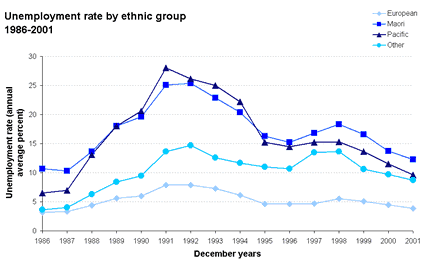
Source: Statistics New Zealand, Household Labour Force Survey
AGE AND GENDER DIFFERENCES
Unemployment rates among different age groups have followed similar trends but the level among those aged 15-24 has been consistently more than twice the rate for older groups. The unemployment rate for young people averaged 11.8 per cent in 2001 and this group comprised 39 per cent of all unemployed. Unemployment rates for males and females are similar. Approximately 45 per cent of all unemployed are women.
Table PW1.1: Unemployment rates, by age and gender, 1986, 1992, 2000, 2001
| 1986 (%) | 1992 (%) | 2000 (%) | 2001 (%) | ||
| Age | 15 - 24 | 7.9 | 18.5 | 13.2 | 11.8 |
| 25 - 44 | 3.1 | 9.0 | 4.9 | 4.4 | |
| 45 - 64 | 1.8 | 6.2 | 3.9 | 3.3 | |
| Gender | Males | 3.6 | 10.9 | 6.1 | 5.4 |
| Females | 4.6 | 9.6 | 5.8 | 5.3 |
Source: Statistics New Zealand, Household Labour Force Survey
REGIONAL DIFFERENCES
In 2001, regional unemployment rates were highest in Bay of Plenty (8.0 percent) and Northland (7.9 percent) and lowest in Southland (3.4 percent), Tasman-Nelson-Marlborough-West Coast (3.5 percent) and Wellington (4.2 percent).
INTERNATIONAL COMPARISON
New Zealand's unemployment rate relative to those of other OECD countries has ranged from being one of the lowest 15 years ago, to well above average by 1992, to around or just below average over the past four years. In 2001, New Zealand's standardised unemployment rate of 5.3 percent ranked behind the United States (4.8 percent), Japan and the United Kingdom (both 5.0 percent) and Sweden (5.1 percent) but ahead of Australia (6.7 percent)44.
Employment
DEFINITION
The proportion of all people aged 15-64 years who are in paid employment for at least one hour per week.
RELEVANCE
The employment rate is the best available indicator of the prevalence of paid employment. It captures trends in both unemployment and labour force participation (the proportion of the working age population that is either employed or unemployed).
CURRENT LEVEL AND TRENDS
In 2001, the surveyed employment rate averaged 71.8 percent of 15-64 year olds were employed for at least one hour per week with an average of 1,786,800 people aged 15-64 in work. The 2001 employment rate was almost the same as the rates recorded in 1986 and 1987 (72 percent). The employment rate has been rising since 1992, except during the economic downturn in 1997 and 1998. The increase from 65.3 percent in 1992 to 71.8 percent in 2001 corresponds to a rise of 331,800 in the number of employed people aged 15-64. Over the same period, the number of people aged 15-64 increased by 260,100.
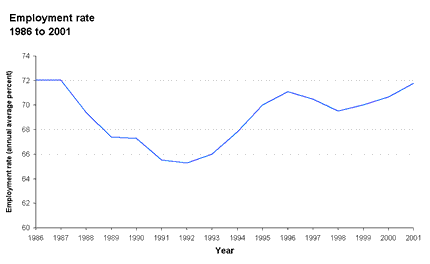
Source: Statistics New Zealand, Household Labour
Force Survey
Note: Based on population aged 15-64
ETHNIC DIFFERENCES
The proportions of the European, Māori and Pacific working age populations in employment all fell between 1987 and 1992 and have risen since then. The only ethnic group to have higher employment rates in 2001 than in the mid-1980s is the European only group (76.7 percent employed in 2001, compared with 73.5 percent in 1986). Māori and Pacific employment rates were just over 58 percent in 2001, still below 1986 levels of 61.9 percent and 67.2 percent, respectively. The employment rate for the "Other" ethnic category has fallen from being the second highest in the late 1980s to the lowest in the late 1990s, reflecting the impact of migration and the difficulties experienced by some newer migrants in integrating into the New Zealand labour market45.
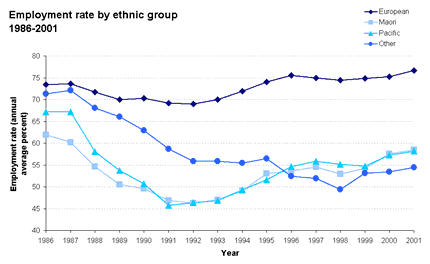
Source: Statistics New Zealand, Household Labour
Force Survey
Note: Based on population aged 15-64
AGE AND GENDER DIFFERENCES
The employment rate decline between 1987 and 1992 affected all age groups, but was most pronounced for young people. Youth employment rates have remained relatively low during the period of employment growth since 1992, possibly due to growth in participation in tertiary education and training. Conversely, employment rates for people aged 45-64 have grown strongly since 1992, driven mostly by the phasing in of the higher age of eligibility for New Zealand Superannuation.
The women's employment rate is significantly lower than that of men, owing mainly to women's greater role in childcare responsibilities. The gap has, however, narrowed somewhat since the mid-1980s. This is the result of a long-term trend of increasing female labour force participation combined with a decline in male employment rates.
Table PW2.1: Employment rates, by age and gender, 1986, 1992, 2000, 2001
| 1986 | 1992 | 2000 | 2001 | ||
| Age | 15-24 | 67.1 | 53.1 | 54.7 | 56.0 |
| 25-44 | 79.4 | 73.7 | 77.2 | 77.9 | |
| 45-64 | 65.1 | 62.1 | 71.9 | 73.6 | |
| Gender | Males | 84.1 | 73.3 | 78.0 | 78.9 |
| Females | 60.0 | 57.3 | 63.5 | 64.9 |
Source: Statistics New Zealand, Household Labour Force Survey
REGIONAL DIFFERENCES
In 2001, employment rates were highest in Wellington (66.2 percent) and the Tasman-Nelson-Marlborough-West Coast region (65.3 percent). Northland (55.3 percent) and the Bay of Plenty (57.4 percent) have the lowest rates, driven partly by high unemployment in these regions.
INTERNATIONAL COMPARISONS
In 2000, New Zealand had the tenth highest employment rate (for people aged 15 and over) out of 29 OECD countries. The New Zealand rate was behind that of the UK, United States and most of the Scandinavian countries. Differences in female labour force participation rates are a key factor in international variation in employment rate.
Workplace injury claims
DEFINITION
The number of workplace accident insurance claims reported to the Accident Insurance Regulator per 1,000 full-time equivalent employees.
RELEVANCE
Safety at work is an important contributor to well-being and the risk of work-related accidents or illness can be seen as one component of the quality of work. The best currently available measure of incidence of workplace injuries comes from the Accident Insurance Regulator's database of claims reported to it.
CURRENT LEVEL
As at September 2001, 226,932 work-related claims had been reported to the Accident Insurance Regulator for injuries incurred during the year to June 2001, a four percent increase on the previous year. This represents a rate of 143 claims per 1,000 full-time equivalent employees, a slight increase from the 2000 rate of 140 per 1,000. The majority of claims were for medical treatment only (i.e. not including weekly compensation). Eighty-two per cent of claims were in respect of employees, the remainder being for self-employed (including employers).
Prior to 1999/2000 data was collected by the Accident Compensation Corporation (ACC) on a different basis from that now used by the Accident Insurance Regulator. The number of claims reported to the ACC was approximately constant between 1994/95 and 1996/97 and then fell (from 281,000 to 243,000) up to 1998/99. Total claims reported to the Regulator in 1999/2000 were 10 per cent lower than the number reported to ACC in the previous year, but it is difficult to conclude much from this difference because of the different collection methods used. The number of claims for weekly compensation was similar for the two years.
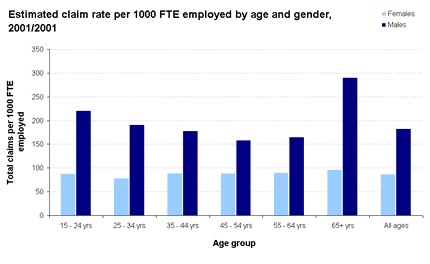
Source: Department of Labour, 2001
The 2000/2001 accident claims include 49 work-related fatalities. It is likely that this is a slight underestimate of the actual number of fatalities, because of time lags in lodging claims and because in some circumstances there may be no claim made in relation to a fatal accident. Construction and transport accounted for 29 percent of work-related fatalities, and agriculture for over a fifth (22 percent).
AGE AND GENDER DIFFERENCES
Males are more than twice as likely as females to have workplace accidents involving an accident insurance claim (183 per 1,000 full-time equivalents (FTEs) for males compared with 87 per 1,000 FTEs for females). Among males, the highest accident claim rate was for males aged 65 and over followed by the 15-24 and 25-34 year age groups. Among women, age differences in the accident claim rate were less pronounced.
ETHNIC DIFFERENCES
Workplace accident claim rates are higher for Māori (177 per 1,000 FTEs) than for other ethnic groups. This is likely to reflect the fact that Māori are disproportionately employed in industries, such as forestry, and occupations that have high accident rates. In 2001, the next highest rate was that for Europeans (128 per 1,000 FTEs), followed by Pacific peoples (126 per 1,000 FTEs). The "Other" ethnic group has the lowest accident claim rate (104 per 1,000 FTEs).
Table PW3.1 New workplace accident claims, by ethnicity, 2000/2001
| Industry | Number of claims | Rate per 1,000 FTEs |
| European | 164,322 | 128 |
| Māori | 24,799 | 177 |
| Pacific | 8,558 | 126 |
| Other | 9,435 | 104 |
| Not specified | 19,818 | |
| Total | 226,932 | 143 |
Source: Department of Labour 2001
INDUSTRY DIFFERENCES
Variation in accident rates for different industries underlies many of the differences in accident rates for males and females, and ethnic and age groups. The highest accident rates are in Forestry (227 per 1,000 FTEs), Agriculture (209 per 1,000 FTEs), and Construction (197 per 1,000 FTEs) industries.
Table PW3.2 New workplace accident claims, by industry, 2000/2001
| Industry | Number of claims | Rate per 1,000 FTEs |
| Forestry | 1,738 | 227 |
| Agriculture | 24,369 | 209 |
| Construction | 21,068 | 197 |
| Mining and quarrying | 599 | 174 |
| Manufacturing | 45,633 | 169 |
| Hunting and fishing | 1,017 | 114 |
| Transport, storage and communication | 10,999 | 106 |
| Electricity, water and gas | 874 | 97 |
| Wholesale, retail, restaurants and hotels | 31,783 | 94 |
| Government, community, social and personal services | 30,695 | 77 |
| Business and financial services | 11,681 | 53 |
Source: Department of Labour 2001
